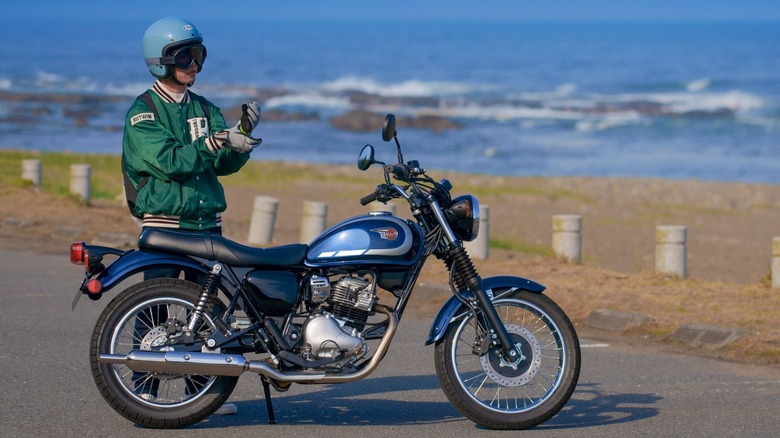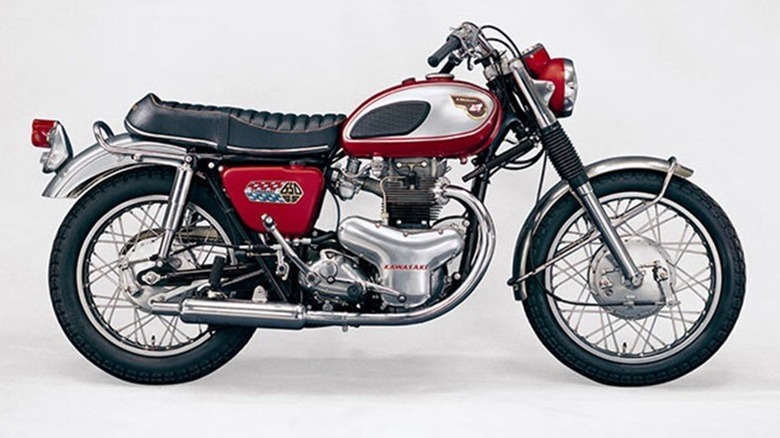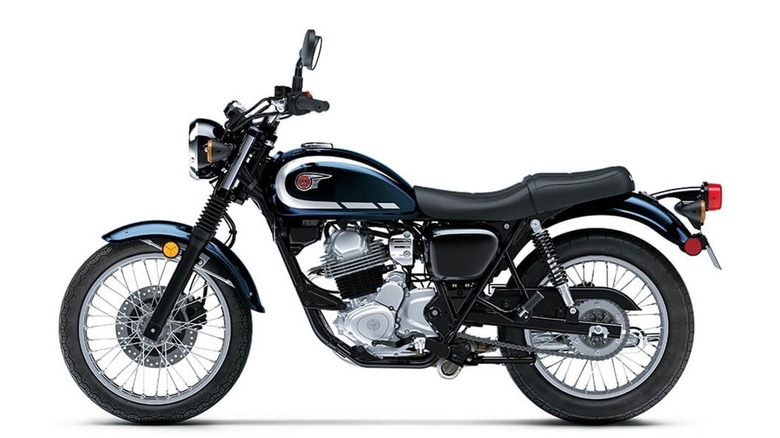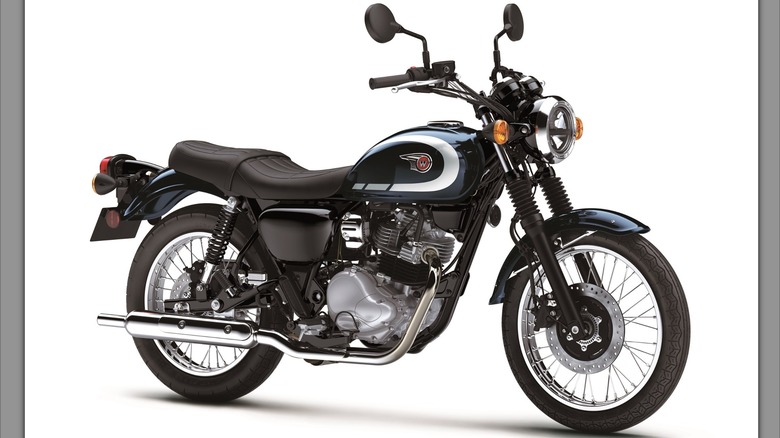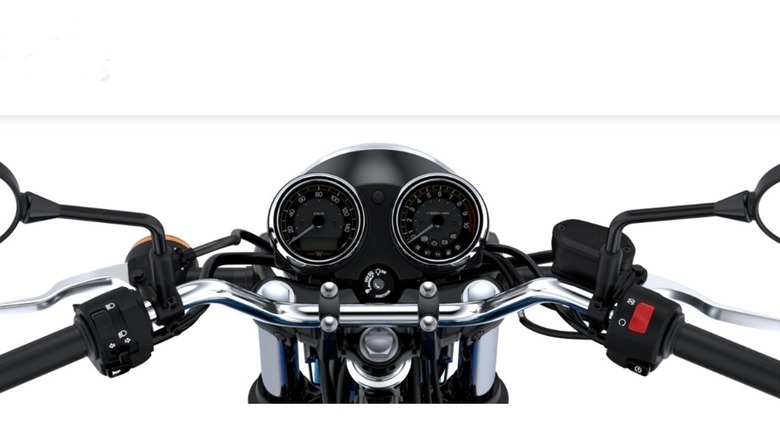Kawasaki W230: 4 Facts About This Retro-Styled Motorcycle
It's no secret that retro styles are back in favor, as evidenced by recent automobile offerings like the Ford Mustang, Chevy Camaro, Dodge Challenger, and Ford Bronco. Retro-style motorcycles are popular as well, with examples from Triumph, Ducati, BMW, and Japanese brands, including Kawasaki, coming to the market in recent years.
Kawasaki has a history of producing memorable motorcycles and its W-series bikes are but one example of that success. Kawasaki advertises its newest W-series motorcycle, the W230 ABS, as a blend of retro style and modern performance, a combination the company calls "Retro Sport." In addition to its retro paint scheme, the Kawasaki W230 ABS features the classic lines and elegant style that remind us of a time when motorcycles were simple machines.
Kawasaki has taken the best parts of that simplicity and enhanced it with the modern safety systems, technology, and reliability that's been developed for the best Kawasaki motorcycles ever made. Let's explore some facts about the all-new retro-styled 2025 Kawasaki W230 ABS.
The Kawasaki W230 ABS demonstrates classic retro-style
The 2025 Kawasaki W230 ABS is the latest iteration, and a continuation, of the brand's classically styled W-series motorcycles. The first Kawasaki W motorcycle, the 650-W1 (shown above), hit the streets of Japan in 1965 (arriving in America in February 1966) shortly after the Kawasaki Aircraft Co. Ltd. took over long-time Japanese motorcycle manufacturer, Meguro Manufacturing Co. Motorcycle Works.
The Kawasaki 650-W1 featured bright colors, copious chrome adornments, and a large-displacement 624cc parallel-twin engine, three things that set it apart from other Japanese motorcycles of the time. Several iterations of the 650-W family came and went until it was discontinued in 1974. Its return to production in 1999 saw its engine increased to 675cc, while maintaining the W650 name through 2009.
The Kawasaki W800, introduced in 2011, was another example popular with American motorcyclists. It continued to carry the spacious riding position, bright finishes, and pea-shooter muffler of the original, but its increased engine displacement provided more power. The W800 would see production cease in 2016, but come right back with improvements and remain in the Kawasaki lineup through today.
While one of the smallest displacement Kawasaki W motorcycles, the W230 ABS remains true to the original's classic style with an honorable retro look. Its brightly colored gas tank and fenders, polished chrome accents, and pea-shooter muffler would fit right in if transported back to 1965, although the electric start might give it away.
The Kawasaki W230 ABS costs a little more than its competitors
As a retro-styled 250-class motorcycle, it's difficult to compile a list of peers for the Kawasaki W230 ABS. The V Star 250, one of Yamaha's last remaining cruisers, comes to mind as with its comparable engine displacement. With its $4,699 MSRP the 2024 Yamaha V Star 250 is priced $900 less than the Kawasaki W230 ABS with its $5,599 MSRP, but does the V Star exhibit retro style, or classic cruiser?
Honda's bobber-inspired perimeter-framed Rebel 300 could be a consideration for those shopping for a small-displacement retro-ish motorcycle. While the naked look isn't exactly retro, it'll appeal to some riders. The Honda Rebel 300 comes with or without ABS, the latter, at $5,149 MSRP, is the closest comparison to the Kawasaki W230 ABS although still $450 cheaper.
There's nothing retro about the 2024 Suzuki GSX250R ABS. Although it features a similar 250cc-class engine displacement, its MSRP starts at $5,099, $500 less than the Kawasaki W230 ABS.
The Kawasaki W230 ABS is a good beginner motorcycle
The Kawasaki obviously isn't among the cheapest 250cc motorcycles. However, it's still a good option for first time riders. If you're looking for a motorcycle to get into street riding for the first time, there are some things every new motorcycle rider should know. Among the most important is what makes a motorcycle legal for your age, experience level, and applicable license type in your state. Every state has a particular set of regulations, but in general, the Kawasaki W230 ABS is an acceptable entry-level motorcycle.
Legality is only part of what makes a good beginner motorcycle. The Kawasaki W230 ABS is powered by an air-cooled four-stroke 233cc single-cylinder engine. The absence of a liquid cooling system means one less maintenance item to contend with, and its 14 lb-ft of torque at 5,800 rpm makes it easy to get things rolling from a standing start. Furthermore, its low 29.3-inch seat height, predictable ABS braking, and 315-pound curb weight help inspire confidence with increased control in all conditions.
The Kawasaki W230 ABS has a simple, comfortable rider interface
The Kawasaki W230 ABS features an upright riding position with comfortable ergonomics. Large round rearview mirrors on each side of the handlebars provide a clear view of the traffic behind, and the square rear brake pedal and accessible foot shifter make operating the bike's foot controls a breeze, even when wearing riding boots.
A single 130 mm LED headlight is housed in the Kawasaki W230 ABS' retro-style headlight housing with two chambers for low and high beams. The fender-mounted tail light keeps with the retro theme, while unobtrusive amber-lensed turn indicators flank both sides front and rear. Standard thumb-operated controls for high/low beams, turn signals, and horn are located on the left side of the handlebar, while the engine kill switch and starter button occupy space on the right side.
Dual circular gauges are clearly visible from the rider's seat and offer a host of information while maintaining the bike's aesthetic. The left side gauge houses the speedometer along with a multi-function LCD screen to display the odometer, trip meter, and clock. The right-hand gauge houses the tachometer and includes indicator lights for turn signals, high beam, low fuel, and neutral. The gauges feature a black background with a custom yellow font designed to be "functional and visually appealing," according to Kawasaki.
